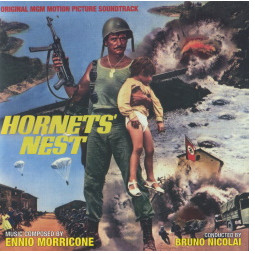主页--->m-comment-000--->mb-comment-009-89
|
电脑版 |
|||||||||||||||||
布罗克斯顿评说莫里康内 MB-009-89 |
||||||||||||||||||
FA7003 Hornet's Nest / 天龙特攻队 / 神龙突击队 |
||||||||||||||||||
作者 乔纳森·布罗克斯顿 (Jonathan Broxton) |
||||||||||||||||||
ENNIO MORRICONE 评论,第9部分 009-89 |
||||||||||||||||||
 |
||||||||||||||||||
黄蜂巢 (1970) 《黄蜂巢》是一部动作战争片,由菲尔·卡尔森执导,洛克·哈德森、西尔瓦·科西纳和塞尔吉奥·范托尼主演。这部电影以 1944 年的意大利北部为背景,讲述了一群十几岁的男孩在纳粹军队在他们村庄犯下的大屠杀中幸存下来的故事。最大的男孩奥尔多发誓要向德国人报仇,当他救出被纳粹伏击的伞兵团的唯一幸存者美国陆军上尉特纳(哈德森饰)时,他找到了这样做的机会。奥尔多绑架了德国医生比安卡·弗里德林(科西娜饰),以照顾特纳恢复健康,然后说服特纳训练他和他的朋友们使用军事武器和战术。 莫里康内为这部电影配乐时只有一个主旋律——一个柔和的木管乐器和叮叮当当的扬琴的总体古典主题,在“主标题”的前半部分首次听到,然后逐渐演变成一种异常轻盈的流行编曲,其中主旋律是吹口哨的。这个主题在整个乐谱中经常出现——在第三个提示“德国医生比安卡”中得到了特别引人注目的陈述,然后在后来的“与男孩的对话”和“一个男孩的死亡”等中得到了特别引人注目的陈述。考虑到电影的性质,主题出奇地轻松,但它确实很好地反映了年轻的主人公,哀叹他们在纳粹侵略面前失去了纯真。有趣的是,特纳船长并没有自己的主题构思——整个配乐都集中在奥尔多和孩子们身上,以及他们对救赎的追求。 当主题不存在时,莫里康内倾向于用一系列大气的乐曲来为动作和悬念配乐,用于弦乐延音和听起来令人不安的不和谐色彩;在“Guns in the Tunnel”、“Radio Research”和“The Dike”等曲目中可以听到这种大气写作的好例子,这增加了电吉他的紧张感。也许最好的动作提示是“Blowing the Dam”,它的管弦乐织体略微更宽泛,并且随着它的发展而变得非常紧张和焦虑。 《大黄蜂巢》是莫里康内 1970 年代电影作品中较为晦涩难懂的配乐之一,多年来一直只能通过盗版获得,直到 2010 年由西班牙唱片公司 Quartet Records 发行,作为 2008 年米高梅原声带宝库盒装的一部分,以 Lukas Kendall 和 Film Score Monthly 的早期发行为基础。这是莫里康内电影作品中的一部小作品,但对完成者来说会很有趣,而且主题很漂亮。 曲目列表: 1. 主标题 (2:08), 2.寻找游击队医生 (:27), 3.比安卡,德国医生 (5:02), 4.隧道里的枪 (1:55), 5.无线电 – 研究 (2:05), 6.打开窗口 (1:27), 7.无线电 – 联系 (1:42), 8.堤坝 (:55), 9.森林研究 (2:08), 10.比安卡和特纳 (1:13), 11.对话医生-美国士兵 (1:30), 12.与男孩们的对话(1:18),13。男孩跑到河边 (2:08), 14.炸毁大坝 (6:31), 15.一个男孩的死亡(:36),16。男孩和德国军官的战斗 (1:20), 17.片尾字幕 (3:44), 18.林中研究(候补)(2:08),19。对话医生-美国士兵(电影版)(1:23),20。男孩和德国军官的战斗(候补)(1:20),21。片尾字幕(单次编辑)(2:31)。四重奏记录QRSCE-011,43分31秒。 |
||||||||||||||||||
2021.2.7 |
||||||||||||||||||
|
| ||||||||||||||||||
以下是原文
| ||||||||||||||||||
ENNIO MORRICONE REVIEWS, Part 9-89 |
||||||||||||||||||
HORNETS’ NEST (1970) Hornets’ Nest is an action war film directed by Phil Karlson and starring Rock Hudson, Sylva Koscina, and Sergio Fantoni. The film is set in Northern Italy in 1944 and follows a group of teenage boys who survive a massacre perpetrated by the Nazi army in their village. The oldest of the boys, Aldo, vows revenge against the Germans, and finds an opportunity to do that when he rescues American Army captain Turner (Hudson), the only survivor of a paratroop regiment that is ambushed by the Nazis. Aldo kidnaps Bianca Freedling (Koscina), a German doctor, to nurse Turner back to health, and then convinces Turner to train him and his friends in the use of military weapons and tactics. Morricone scored the film with just one main theme – an overarching classical theme for gentle woodwinds and tinkling dulcimers first heard in the first half of the “Main Titles,” which then gradually morphs into an unusually light pop arrangement in which the main melody is whistled. The theme reappears frequently throughout the score – it receives especially notable statements in the third cue “Bianca, the German Doctor,” and then later in “Dialogue With the Boys” and “Death of a Boy,” among others. The main theme is surprisingly light, considering the nature of the film, but it does reflect the young protagonists well, lamenting for their loss of innocence in the face of Nazi aggression. Interestingly, Captain Turner does not have a thematic idea of his own – the entire score is focused on Aldo and the children, and their quest for redemption. When theme is not present Morricone tends to score the action and suspense with a series of atmospheric pieces for string sustains and uneasy-sounding dissonant colors; good examples of this atmospheric writing can be heard in tracks such as “Guns in the Tunnel,” “Radio Research,” and “The Dike,” which adds to the tension with an electric guitar. Perhaps the best action cue is “Blowing the Dam,” which features slightly more expansive orchestral textures, and becomes quite taut and anxious as it develops. Hornet’s Nest was one of the more obscure scores in Morricone’s 1970s filmography for many years, available only via bootlegs, until it was released by Spanish label Quartet Records in 2010, building off an earlier release from Lukas Kendall and Film Score Monthly as part of the 2008 MGM Soundtrack Treasury box set. It’s a minor work in Morricone’s filmography, but will be interesting to completists, and the main theme is pretty. Track Listing: 1. Main Titles (2:08), 2. Looking for a Partisan Doctor (:27), 3. Bianca, the German Doctor (5:02), 4. Guns in the Tunnel (1:55), 5. Radio – Research (2:05), 6. Opening Window (1:27), 7. Radio – Contacting (1:42), 8. The Dike (:55), 9. Research in the Wood (2:08), 10. Bianca and Turner (1:13), 11. Dialogue Doctor-American Soldier (1:30), 12. Dialogue with the Boys (1:18), 13. Boys Running to the River (2:08), 14. Blowing the Dam (6:31), 15. Death of a Boy (:36), 16. Boy and German Officer Fighting (1:20), 17. End Titles (3:44), 18. Research in the Wood (Alternate) (2:08), 19. Dialogue Doctor-American Soldier (Film Version) (1:23), 20. Boy and German Officer Fighting (Alternate) (1:20), 21. End Titles (Single Edit) (2:31). Quartet Records QRSCE-011, 43 minutes 31 seconds. |
||||||||||||||||||
Feb. 7, 2020 |
||||||||||||||||||
本站电影欣赏 |
||||||||||||||||||
在线音乐试听 |
||||||||||||||||||
 |
||||||||||||||||||
Jon 是一位电影音乐评论家和记者,自 1997 年以来一直担任全球最受欢迎的英语电影音乐网站之一 Movie Music UK 的编辑和首席评论员,并且是国际电影音乐评论家协会 (IFMCA) 的主席。在过去的 20多 年中,Jon 撰写了 3,000 多篇评论和文章,并进行了多次作曲家采访。在杂志刊物方面,乔恩曾为《电影配乐月刊》、《原声带杂志》和《电影音乐》等出版物撰写评论和文章,并为普罗米修斯唱片公司的两张经典 Basil Poledouris 配乐专辑《Amanda》和《Flyers / Fire on the Mountain》撰写了衬垫注释。他还为汤姆·胡佛 (Tom Hoover) 于 2011 年出版的《Soundtrack Nation: Interviews with Today's Top Professionals in Film, Videogame, and Television Scorering》一书撰写了一章。在1990年代后期,乔恩是伦敦皇家爱乐乐团的电影音乐顾问,并与他们合作拍摄了约翰·德布尼(John Debney)的音乐电影《相对价值》(Relative Values)和奥利弗·海斯(Oliver Heise)的音乐《佛陀的指环》(The Ring of the Buddha),以及与兰迪·纽曼(Randy Newman)合作的一系列音乐会。2012年,乔恩在波兰克拉科夫举行的第五届年度电影音乐节上担任“电影节学院”主席。他是作曲家和作词家协会的成员,该协会是作曲家、作词家和词曲作者从事电影、电视和多媒体工作的首要非营利组织。 |
||||||||||||||||||
2023.12.10 |
||||||||||||||||||
2023 手机版 |
||||||||||||||||||
|
||||||||||||||||||













